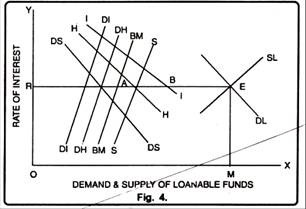The neo-classical theory of interest or loanable funds theory of interest owes its origin to the Swedish economist Knut Wicksell.
Later on, economists like Ohlin, Myrdal, Lindahl, Robertson and J. Viner have considerably contributed to this theory.
According to this theory, rate of interest is determined by the demand for and supply of loanable funds. In this regard this theory is more realistic and broader than the classical theory of interest.
Demand for Loanable Funds:
Loanable funds theory differs from the classical theory in the explanation of demand for loanable funds.
ADVERTISEMENTS:
According to this theory demand for loanable funds arises for the following three purposes viz.; Investment, hoarding and dissaving:
1. Investment (I):
The main source of demand for loanable funds is the demand for investment. Investment refers to the expenditure for the purchase of making of new capital goods including inventories. The price of obtaining such funds for the purpose of these investments depends on the rate of interest. An entrepreneur while deciding upon the investment is to compare the expected return from an investment with the rate of interest. If the rate of interest is low, the demand for loanable funds for investment purposes will be high and vice- versa. This shows that there is an inverse relationship between the demands for loanable funds for investment to the rate of interest.
2. Hoarding (H):
The demand for loanable funds is also made up by those people who want to hoard it as idle cash balances to satisfy their desire for liquidity. The demand for loanable funds for hoarding purpose is a decreasing function of the rate of interest. At low rate of interest demand for loanable funds for hoarding will be more and vice-versa.
3. Dissaving (DS):
Dissaving’s is opposite to an act of savings. This demand comes from the people at that time when they want to spend beyond their current income. Like hoarding it is also a decreasing function of interest rate.
Supply of Loanable Funds:
The supply of loanable funds is derived from the basic four sources as savings, dishoarding, disinvestment and bank credit.
ADVERTISEMENTS:
They are explained as:
1. Savings (S):
Savings constitute the most important source of the supply of loanable funds. Savings is the difference between the income and expenditure. Since, income is assumed to remain unchanged, so the amount of savings varies with the rate of interest. Individuals as well as business firms will save more at a higher rate of interest and vice-versa.
2. Dishoarding (DH):
Dishoarding is another important source of the supply of loanable funds. Generally, individuals may dishoard money from the past hoardings at a higher rate of interest. Thus, at a higher interest rate, idle cash balances of the past become the active balances at present and become available for investment. If the rate of interest is low dishoarding would be negligible.
3. Disinvestment (DI):
ADVERTISEMENTS:
Disinvestment occurs when the existing stock of capital is allowed to wear out without being replaced by new capital equipment. Disinvestment will be high when the present interest rate provides better returns in comparison to present earnings. Thus, high rate of interest leads to higher disinvestment and so on.
4. Bank Money (BM):
Banking system constitutes another source of the supply of loanable funds. The banks advance loans to the businessmen through the process of credit creation. The money created by the banks adds to the supply of loanable funds.
Determination of Rate of Interest:
According to loanable funds theory, equilibrium rate of interest is that which brings equality between the demand for and supply of loanable funds. In other words, equilibrium interest rate is determined at a point where the demand for loanable funds curve intersects the supply curve of loanable funds. It can be shown with the help of a Figure 4.
The rate of interest is determined at the point of intersection of the two curves—the supply of loanable funds curve (SL) and the demand for loanable funds curve, DL. Fig. 4 shows that the equilibrium rate of interest is EM; at this rate, the demand for loanable funds is equal to the supply of loanable funds i.e. OM.
Criticism:
Although, loanable funds theory is superior to classical theory, yet, critics have criticised it on the following grounds:
1. Full Employment:
Keynes opined that loanable funds theory is based on the unrealistic assumption of full employment. As such, this theory also suffers from the defects as the classical theory does.
2. Indeterminate:
Like classical theory, loanable funds theory is also indeterminate. This theory assumes that savings and income both are independent. But savings depend on income. As the income changes savings also change and so does the supply of loanable funds.
3. Impracticable:
This theory assumes savings, hoarding, investment etc. to be related to interest rate. But in actual practice investment is not only affected by interest rate but also by the marginal efficiency of capital whose affect has been ignored.
4. Unsatisfactory Integration of Real and Monetary Factors:
ADVERTISEMENTS:
This theory makes an attempt to integrate the monetary as well as real factors as the determinants of interest rate. But, the critics have maintained that these factors cannot be integrated in the form of the schedule as is evident from the frame work of this theory.
5. Constancy of National Income:
Loanable funds theory rests on the assumption that the level of national income remains unchanged. In reality, due to the change in investment, income level also changes accordingly.
Improvement over the Classical Theory:
Loanable funds theory is considered to be an improvement over the classical theory on the following aspects:
1. Loanable funds theory recognizes the importance of hoarding as a factor affecting the interest rate which the classical theory has completely overlooked.
ADVERTISEMENTS:
2. Loanable funds theory links together liquidity preference, quantity of money, savings and investment.
3. Loanable funds theory takes into consideration the role of bank credit which acts as a very important source of loanable funds.
